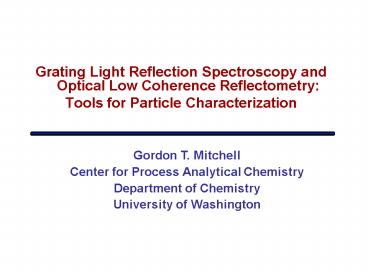Grating Light Reflection Spectroscopy and Optical Low Coherence Reflectometry: - PowerPoint PPT Presentation
1 / 36
Title: Grating Light Reflection Spectroscopy and Optical Low Coherence Reflectometry:
1
- Grating Light Reflection Spectroscopy and Optical
Low Coherence Reflectometry - Tools for Particle Characterization
Gordon T. Mitchell Center for Process Analytical
Chemistry Department of Chemistry University of
Washington
2
Sensor Development
Fundamental science
Develop
Build
Commercial products
Model Systems
Test
3
Outline
- Introduction
- Grating Light Reflection Spectroscopy
- Optical Low Coherence Reflectometry
- Conclusion
4
Grating Light Reflection Spectroscopy
GLRS simultaneously measures
Refractive Index n (T,?)
Attenuation Index K (T,?)
Scattering
Absorbance
Chromophore Concentration
Speed of Light Analyte concentration
Particle Size Particle Concentration
- UV Aromatics conc.
- Vis Dye conc.
- Near-IR Water conc.
- Emulsions
- Pigments
- Cosmetics
- Drug Attrition Milling
- Heterogeneous Slurries
- Universal RI Detection
- Mixing applications
5
GLRS Mechanism
Polychromatic light
Reflected orders
Air e(0)
Substrate e(1)
?cr when ?d90o
Grating
650 nm
600 nm
550 nm
500 nm
?d
450 nm
400 nm
Diffracted orders
Evanescent field
Sample e(2)
Transmitted orders
6
GLRS Theory
Critical wavelength depends on sample refractive
index, n.
Signal intensity depends on attenuation index, k.
7
GLRS Instrumentation
Goniometer for angle-based GLRS measurements
8
GLRS Instrumentation
Dip Probe for Microreactor and NeSSI integration
9
GLRS Instrumentation
Fabricated inside a microfluidic system
10
Other GLRS Work
Grating Modulation for Chemical Sensing
Hydrogen Sensing
Spectroelectrochemistry
11
Particle Analysis with GLRS
Nanoparticle Analysis
- Analyzed a series of dendritic oligomers in
nanometer sampling volumes. - Particles detected down to 0.75 nm diameter
- Able to discriminate between particles with
sub-nanometer differences in diameter.
Smith, S.A. Brodsky, A.M. Vahey, P.G. Burgess,
L.W. Anal. Chem. 2000, 72, 4428-4434
12
Particle Analysis with GLRS
Naproxen Attrition Milling
Theoretical monodisperse spectra
Observed polydisperse spectra
Hamad, M.L. Kailasam, S. Brodsky, A.M. Han,
R. Higgins, J.P. Thomas, D. Reed, R.A.
Burgess, L.W. Appl. Spectrosc. 2005, 59.
13
Particle Analysis with GLRS
Naproxen Attrition MillingPCA of 2nd Derivative
GLRS Spectra
14
Polystyrene Model Particle System
- Narrow size distribution
- Acid functionality
- Well-characterized by sponsor
- Large amount (100 g each)
- Can dilute with 0.05 sodium lauryl sulfate
First Research Objective How well can we
determine solids concentration and how well can
we discriminate based on particle size?
15
Particle Analysis with GLRS
Rayleigh Scattering
Fraunhofer Scattering
3
15
30
16
Constant Particle Concentration
30
15
Increasing diameter
Size discrimination better at higher
concentrations.
7.5
0.94
17
Constant Particle Diameter
127 nm particles
220 nm particles
- Particle diameter is held constant, concentration
is varied from 30 solids down to 0.94 solids. - Increasing particle size leads to higher
effective sample refractive index. - Scattering intensity decreases as particle
diameter approaches the wavelength of incident
light.
18
Polydisperse Particle Systems
Grating Rotation
Polarization state changes
19
GLRS Summary
- Simple, robust instrumentation
- Integration into microfluidic systems
- Particle sizing over wide diameter range
- Concentrated, heterogeneous matrices
- Grating modulation for chemical sensing
- Current goal Polydisperse particle systems
20
Outline
- Introduction
- Grating Light Reflection Spectroscopy
- Optical Low Coherence Reflectometry
- Conclusion
21
OLCR Instrumentation
22
OLCR Instrumentation
23
OLCR Spectral Response
Structured systems
Scattering systems
hn
24
Nanoparticle Standards Analysis
Twenty 1 volume fraction polystyrene
samples Diameter range 21-1745 nm RSD of
diameter 0.8 7.1
Seventeen 10 volume fraction latex
samples Diameter range 30-2000 nm RSD of
diameter 3 18
1 Standards Decay Profiles
10 Standards Decay Profiles
25
OLCR Experimental Curve Fitting
A
B
- Previous curve fitting limited to specific
regions on decay curve. - Data were fit without removing secondary
coherence residuals - Current method uses Matlab to remove secondary
coherence residuals remove, fit decay profiles,
and extract relevant parameters.
26
OLCR Experimental Curve Fitting
1 Polystyrene Data Set
27
Fit from Mie Theory
Expression for backscatter intensity
1 Standards a fitting parameter
10 Standards a fitting parameter
In press with Physical Review E
28
PS standards at constant concentration 30.6 wt
Signal in dB
Dwell distance in mm
29
220nm PS 31.9 solids added to .05wt SLS
Signal in dB
Dwell distance in mm
30
220nm PS 31.9 solids added to .05wt SLS
Signal in dB
Dwell distance in mm
31
Dilution of 220nm 31.9 wt PS
Signal in dB
Dwell distance in mm
32
Dilution of 220nm 31.9 wt PS
33
OLCR Summary
- Commerical instruments available
- Refractive index and particle size monitoring
- High and low concentration regimes
- Theoretical model for resonant scattering
- Current goal Polydisperse particle systems
34
Outline
- Introduction
- Grating Light Reflection Spectroscopy
- Optical Low Coherence Reflectometry
- Conclusion
35
Conclusion
Fundamental science
Develop
Build
Ideas
Commercial products
Model Systems
Test
36
Acknowledgements
- Scientific Support
- Dr. Lloyd Burgess
- Dr. Anatol Brodsky
- Dr. Mazen Hamad
- Dr. Summer Randall
- Dr. Joe Dragavon
- Financial Support
- NIH (MLSC)
- DOE
- CPAC































